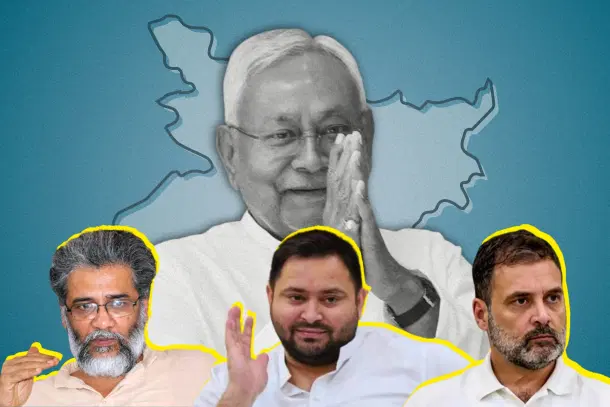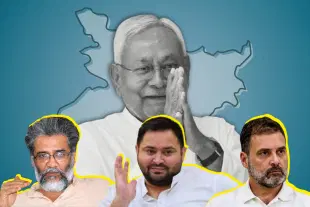Bihar
Bihar Without Nitish: What His Fall Means For Bihar's Opposition
Abhishek Kumar
Oct 15, 2025, 01:23 PM | Updated 01:23 PM IST
Save & read from anywhere!
Bookmark stories for easy access on any device or the Swarajya app.


When Chief Election Commissioner (CEC) Gyanesh Kumar announced the dates for the Bihar Assembly elections (AE), 2025, it marked a transitory day for the state's political spectrum.
For the first time since 2005, Nitish Kumar is not the absolute centre of gravity in Bihar elections. The politician, the administrator, the rare honest socialist, the good opportunist, and Sushashan Babu of Bihar is now in the middle of a drama that will decide how his career ends.
Nitish Kumar as non-playing captain
Naysayers may point out that it could be Kumar's way of ceding space for an eventual reoccupation blitzkrieg. To his credit, Kumar has done it enough times at the peril of his critics. But the difference is that the Nitish Kumar who did these miracles was active, articulate, agile, attentive, and affectionate.
The recent version of Nitish Kumar has acted like an undisciplined prodigy from stages, even disrespecting the national anthem. Maybe not knowingly. His articulation is now limited to fewer sentences, one of which includes reassurance from the stage about not switching sides again. The affection in him has given way to a man who mocks the victims of his haphazard alcohol ban law.
Kumar no longer participates in official formal briefings. People of Bihar rarely see clips of his meetings after a grave tragedy. No minister is being asked to resign after negative headlines like a law and order tragedy, whilst the bureaucracy has gone loose without his firm grip.
In many campaign materials, Prime Minister Modi has often been used as the face of state government schemes. In the last 120 days, his most visible political act has been the 8 AM activity on his X account, in which Kumar regularly announces new schemes and pre-election freebies.
Observers of Patna's power circle explain that there could be some merit in late Sushil Modi's criticism of Kumar's health. In later months, Tejashwi Yadav and Prashant Kishor have also raised the issue, with Kishor demanding a health bulletin. But the man who once anchored every equation has not responded to the queries and is now receding into a quiet presence.
The constrained agency on his own machinery means that his top-down control now goes through a decentralisation process, which in turn opens the floodgates for every possible permutation of political realignment among caste, communal, and developmental lines.
Impact on Rashtriya Janata Dal and Tejashwi Yadav
Over the last two decades, almost all of the NDA's promise was anchored in Lalu-era memory of Jungle Raj and how Nitish Kumar used the law and order machinery to eliminate organised crime. In two decades, no other leader could challenge his stature on this front, which ironically left space for the RJD, the lynchpins of Jungle Raj, to reproject itself with Tejashwi Yadav's suave image.
With talks of employment, education, health, and priority to youth leadership, Yadav has shown considerable effort in trying to capture Kumar's plank. In one of his recent press conferences, Yadav promised to provide a government job to at least one member of nearly three crore families in the state.
Apart from the governance front, he is also targeting to recapture his father's hold on Other Backward Classes (OBC) voters, which Kumar has fragmented by carving out Extremely Backward Classes (EBCs), who comprise 36 per cent of population, nine per cent more than OBCs.
Whilst EBCs remained a scattered group forming mainly of caste groups whose share in the state population is less than 0.5 per cent, Kurmis and Kushwahas, two other OBC communities collectively forming 7.09 per cent, are being courted by RJD. Among them, the Kushwaha voters are his prime target with tickets and other key top positions, including picking a female spokesperson from the community.
After Kushwahas, establishing good faith with Savarnas is also on the horizon. Savarnas in Bihar have given up on hope of a top leadership position due to the politics of the day prioritising backward leaders. With the constricted space, they would pick Nitish Kumar as a backward face rather than any of Lalu Yadav's scions.
As Kumar looks set to disappear from the political horizon and their discontentment with the BJP rises, Tejashwi Yadav looks to approach them, beginning with Bhumihars, the most ostracised upper-caste community during the 1990s.
The risk for Tejashwi is that he may lose grip over his Muslim-Yadav (M-Y) voter base. Muslims have shown signs of siding with the Indian National Congress (INC), whilst surveys indicate a division of Yadav voters in favour of the BJP.
Former RJD leader Akhtarul Imam, who is currently the state chief of Asaduddin Owaisi's All India Majlis-e-Ittehadul Muslimeen (AIMIM), says that 40 per cent of Yadavs have shifted their loyalty to the BJP.
Days ahead for the Left
After the RJD, it is the Left parties that can benefit the most from it, provided that the leadership takes well-timed steps.
The problem for the Left in Bihar has been that it is suffering from the impact of caste-based formations which its movement created in the state. The anti-rich Naxal movement took a casteist turn inside Bihar's borders, worsening an already dilapidated social, political and economic space in which poor Dalits, Mahadalits, and EBC classes suffered most.
During the Lok Sabha elections, this writer was told about the social pressure faced by poor labourers to contribute financially to the Left parties' funds in Begusarai. In Bihar, the Left parties hurt those whom they claimed to benefit from their utopian system.
By mending its ways, the Left has regained some foothold in the state. It secured 16 seats in the 2020 AE and two in the 2024 general elections. The hallmark of these victories is that they were built on the same agitated and disruptive style of politics in which Dalits and EBCs form a major section of the cadre.
Notably, it is inversely linked to the declining face value of Nitish Kumar. That is because the communities which the Left channels itself towards largely have faith in Kumar's leadership. Nitish's administrative delivery acted as a moderate alternative for the same social base the Left traditionally mobilised.
With Nitish's gradual retreat, that protective layer is thinning, offering Left parties an opportunity, which they can cash in on more than the RJD. Unlike the RJD, which operates through a centralised, personality-driven structure, the Left runs through local committees in villages and industrial clusters.
By returning to fragmented trade unions, teachers' fronts, and rural agitation networks, the Left could reclaim its lost space amongst the working poor.
However, its success will depend on whether it can avoid militancy and moral superiority. Biharis now prefer income security and dignity of work over ideological sermons. The Left will need to talk about minimum wages, job regularisation, price rise, and migration instead of utopian revolution, else they will limit themselves to a pressure wing whilst more flexible and emotionally rooted players like Tejashwi Yadav will occupy that space.
What for Congress?
Of all relatively larger opposition parties, it is INC which is least impacted by Nitish Kumar's administration. With his clean politics, Kumar just accelerated its decline after coming to power.
INC's upper caste votes had been secured by BJP, whilst Dalits were taken up by Nitish Kumar and Lalu Yadav, who also consolidated his hold on Muslim voters in Bihar. Kumar's arrival took away a significant chunk of Muslim voters from RJD, hence diminishing the probability of them going back to INC fold.
Upper castes and Dalits also rallied behind his governance appeal.
However, in last few years, INC has shown signs of regaining a foothold amongst Bihari Muslim community, which feel disenfranchised by RJD's preference of Yadavs despite the community being three per cent less than them.
With Kumar's eventual departure, the leftover pro-Nitish Muslim voters are expected to switch their allegiances to INC since the community now vouches for a political unit which can challenge BJP on national level. Additionally, by promoting Kanhaiya Kumar, Bhumihar and Rajesh Ram, a Dalit, INC is also competing with RJD and Left for Upper caste and Dalit vote banks as well.
INC sees its coalition partners as competition. Kumar's departure is also expected to open up the space for more intra-alliance competition.
Paradoxical opportunity for the opposition?
Nitish Kumar's gradual withdrawal from Bihar's political stage presents a paradoxical opportunity for the opposition.
Whilst his diminishing presence removes a unifying figure who once held diverse social coalitions together, it simultaneously opens up fragmented voter bases that multiple opposition parties are now competing to capture.
The RJD's attempt to appropriate Kumar's governance plank, the Left's renewed efforts to mobilise the working poor, and the INC's growing appeal amongst Muslims reflect a broader struggle within the opposition to inherit different fragments of his legacy.
However, this very competition risks weakening the opposition's collective strength against the BJP-led NDA. The 2025 Assembly elections will ultimately reveal whether the opposition can transform Kumar's absence into a strategic advantage by building new coalitions, or whether internal rivalries and overlapping claims to the same voter bases will fragment their challenge to the ruling alliance.
Abhishek is Staff Writer at Swarajya.





